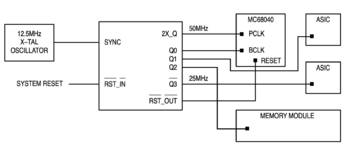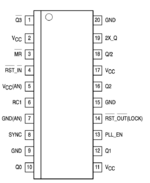"Spicy O'clock" project has started
- Thread starter Kay K.M.Mods
- Start date
You are using an out of date browser. It may not display this or other websites correctly.
You should upgrade or use an alternative browser.
You should upgrade or use an alternative browser.
Looking at the oscillator documentation here : https://www.farnell.com/datasheets/57482.pdf
Apple really brought all relevant signals to the J36 connector so we can easily have a replaceable oscillator. That is crazy.
@Kay K.M.Mods Spicy O'Clock AV special edition ?
Apple really brought all relevant signals to the J36 connector so we can easily have a replaceable oscillator. That is crazy.
@Kay K.M.Mods Spicy O'Clock AV special edition ?
Originally it was 25MHz! sorry for the misunderstanding. It's 3:30am now, so I'll reply tomorrow. CU!I know it's my responsibility
So the black oscillator is 12.5 MHz, half of 25 MHz.
The other crystal is 55.5 MHz, which is, for sure, for the ATT 3210 DSP. (you can zoom on the following picture, from a different angle).
So I'm still pretty convinced this is the black crystal in my case.
In fact I've just had a look at the MC88920, and pin 8, which is SYNC is connected directly to pin 3 of the black crystal. So I have a confirmation
Now... SURPRISE, pin 3 of J36 is connected to that exact same pin. Was J36 meant for an external clock source ? Apple, what are you hiding ! A built-in overclocking connector (yes, I'm a bit excited...), it really looks like it, I'm tempted to solder a connector.
I also marked 2X_Q which feeds PCLK for the 68040.
I'm looking for 660AV schematics... I've seen some floating around, any source ?
View attachment 7156
Have a good night, it's about time !Originally it was 25MHz! sorry for the misunderstanding. It's 3:30am now, so I'll reply tomorrow. CU!
As I said at the beginning, leave the original crystal oscillator alone. It probably won't work if you remove this structurally.

1: INH, Connect this to GND to stop transmission. Leave it N/C this time.
2: GND, Connect with Spicy GND
3: VIN +5V, Connect with Spicy VIN
4: Frequency Output, Leave it N/C this time.
8: Here is the LC575 wiring diagram, floating and separated from the PCB footprint, soldering the Spicy output directly to the leg of the chip.
I can't be held responsible but this should work.
If Q660AV have a 343S1135 chip on the PCB, I don't think this method will work. I need to interrupt the line output from the 343S1135 to the MC88920.
Again, I didn't see the entire logic board, only part of your picture, so I'm not sure. Please take responsibility for your actions.
1: INH, Connect this to GND to stop transmission. Leave it N/C this time.
2: GND, Connect with Spicy GND
3: VIN +5V, Connect with Spicy VIN
4: Frequency Output, Leave it N/C this time.
8: Here is the LC575 wiring diagram, floating and separated from the PCB footprint, soldering the Spicy output directly to the leg of the chip.
I can't be held responsible but this should work.
If Q660AV have a 343S1135 chip on the PCB, I don't think this method will work. I need to interrupt the line output from the 343S1135 to the MC88920.
Again, I didn't see the entire logic board, only part of your picture, so I'm not sure. Please take responsibility for your actions.
Hi @Kay K.M.Mods @Zane Kaminski  (and all others of course... @JDW )
(and all others of course... @JDW )
So I had a bit more time to play and investigate today.
First, I did solder some pins to J36 which makes to more convenient to measure see picture. BTW my wiring was not completely right but that's not the point. I also played with unsoldering the crystal as well, but will not extend on this as anyway, I did lift pin 8 of the divider.
Then, I do confirm that there is NO 343S1135 anywhere, and I include a full size pic of the PCB (was taken before I fully recapped it). There is also none on the backside, just a few unrelated ICs for serial ports and ADB. This is also consistent with the 840AV schematics, and my own continuity measurements.
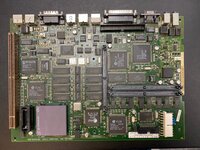
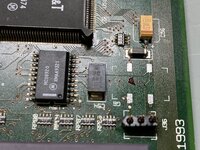
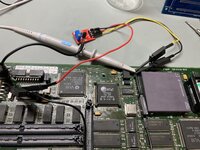
I then used you wiring diagram, and can confirm the Spicy does power up and generate a very nice clock. Minimum I could set is 17.42 MHz.
I then unsoldered pin 8 of the MC88920, and soldered it to the output of the Spicy.
2X_Q jumps to 66.34 MHz, which is 4x the clock. with Q0-Q3 at 34.84 MHz. Spot on (had issues to take pictures of the scope, sorry for the quality)
As I mentioned earlier I have a 68040@33 MHz, so the overclocking would very minimal.
But the Mac clearly would not boot.
I spent a lot of time looking at the 840AV schematics (the only one available), as well as Apple developers note.
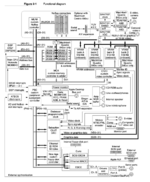
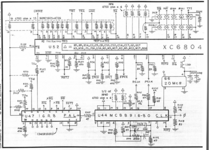
PCLk/4, which is the one we are touching is used only by the divider, but then the result is fed to the other circuits.
There is definitely a large number of clocks derived from PClk and BClk, which are connected to many ASICs (see below).
There is even a difference between the 660av which uses PClk for CIVIC, whereas the 840av does seem to have a different clock for this.
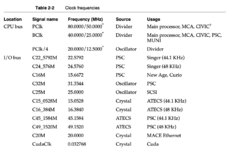

I'm wondering if that doesn't make the overclocking very sensitive to the values that can be used (ie : not any value, but only some of them).
I have tried an exact 20 MHz, to mimic the value in the 840av. All clocks are aligned (80 MHz, 40 MHz), still won't boot.
Any suggestion from anyone ?
Oh, fortunately, all is revertible !
So I had a bit more time to play and investigate today.
First, I did solder some pins to J36 which makes to more convenient to measure see picture. BTW my wiring was not completely right but that's not the point. I also played with unsoldering the crystal as well, but will not extend on this as anyway, I did lift pin 8 of the divider.
Then, I do confirm that there is NO 343S1135 anywhere, and I include a full size pic of the PCB (was taken before I fully recapped it). There is also none on the backside, just a few unrelated ICs for serial ports and ADB. This is also consistent with the 840AV schematics, and my own continuity measurements.



I then used you wiring diagram, and can confirm the Spicy does power up and generate a very nice clock. Minimum I could set is 17.42 MHz.
I then unsoldered pin 8 of the MC88920, and soldered it to the output of the Spicy.
2X_Q jumps to 66.34 MHz, which is 4x the clock. with Q0-Q3 at 34.84 MHz. Spot on (had issues to take pictures of the scope, sorry for the quality)
As I mentioned earlier I have a 68040@33 MHz, so the overclocking would very minimal.
But the Mac clearly would not boot.

I spent a lot of time looking at the 840AV schematics (the only one available), as well as Apple developers note.


PCLk/4, which is the one we are touching is used only by the divider, but then the result is fed to the other circuits.
There is definitely a large number of clocks derived from PClk and BClk, which are connected to many ASICs (see below).
There is even a difference between the 660av which uses PClk for CIVIC, whereas the 840av does seem to have a different clock for this.


I'm wondering if that doesn't make the overclocking very sensitive to the values that can be used (ie : not any value, but only some of them).
I have tried an exact 20 MHz, to mimic the value in the 840av. All clocks are aligned (80 MHz, 40 MHz), still won't boot.
Any suggestion from anyone ?
Oh, fortunately, all is revertible !
Sorry for not being helpful, but I will get same Mac if I have a chance.
Oh if there are sources for reliable 68040RC40
Hey @iPhil64
I've been thinking what you are trying to do with the Quadra660AV, I searched a lot but could not find useful information about Overclocking. One thing I learned is that the crystal oscillator replacement is limited to 17.4Mhz, which means that the CPU clock is limited to 35MHz.
But, I'll let you know how you can set it a little lower the SpicyO'Clock!
Insert a 1K ohm resistor in place of the jumper pin in the SL mode position. In this case, The maximum frequency that can be adjusted with the trimmer pot is about 17.3MHz (minimum 14.8MHz), I think that it is good to explore the frequency that Mac can boot.
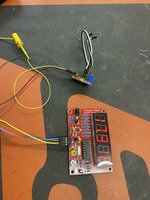
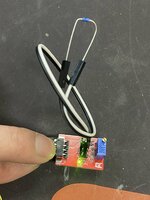
I've been thinking what you are trying to do with the Quadra660AV, I searched a lot but could not find useful information about Overclocking. One thing I learned is that the crystal oscillator replacement is limited to 17.4Mhz, which means that the CPU clock is limited to 35MHz.
But, I'll let you know how you can set it a little lower the SpicyO'Clock!
Insert a 1K ohm resistor in place of the jumper pin in the SL mode position. In this case, The maximum frequency that can be adjusted with the trimmer pot is about 17.3MHz (minimum 14.8MHz), I think that it is good to explore the frequency that Mac can boot.


Last edited:
Hey no worry, I'm here to explore things ! ):Sorry for not being helpful, but I will get same Mac if I have a chance.
Excellent, let me try that.Hey @iPhil64
I've been thinking what you are trying to do with the Quadra660AV, I searched a lot but could not find useful information about Overclocking. One thing I learned is that the crystal oscillator replacement is limited to 17.4Mhz, which means that the CPU clock is limited to 35MHz.
But, I'll let you know how you can set it a little lower the SpicyO'Clock!
Insert a 1K ohm resistor in place of the jumper pin in the SL mode position. In this case, The maximum frequency that can be adjusted with the trimmer pot is about 17.3MHz (minimum 14.8MHz), I think that it is good to explore the frequency that Mac can boot.
View attachment 7251
View attachment 7252
In my previous experiment, you can see the lowest frequency I got was 17.42 MHz, but maybe I'm not luck with the 33 MHz rated CPU.
So let's try the resistor to explore slightly lower frequencies
So @Kay K.M.Mods it kind of works.
Lowering further the clock, I could have some overclocking.
I could reach 16.5 MHz (so 33 MHz CPU, which is normally within specs), the Mac would boot, but plugging any device will make it hang immediately (even a keyboard).
Using 15.0 MHz (30 MHz, only 5 MHz overclock) seems to be quite stable for some time.
Given the architecture diagram above, it may well be some of the other ASICs that do not support overclocking, or can not sync various clocks.
MCA, CIVIC and PSC do get their clocking signal from the divider, they may not be as tolerant as the CPU, which is technically still under clocked from what it should be able to deliver. Or maybe I'm not lucky and Motorola did recycle some bad 33 MHz CPUs as 25 MHz ones.... who knows what happened back in 1993.
Now I have recapped the board, not the power supply.
Looking with the scope at the 5V rails, there is a lot of noise that feeds back, and that seems strange to me.
A lot of fun for exploration !
Lowering further the clock, I could have some overclocking.
I could reach 16.5 MHz (so 33 MHz CPU, which is normally within specs), the Mac would boot, but plugging any device will make it hang immediately (even a keyboard).
Using 15.0 MHz (30 MHz, only 5 MHz overclock) seems to be quite stable for some time.
Given the architecture diagram above, it may well be some of the other ASICs that do not support overclocking, or can not sync various clocks.
MCA, CIVIC and PSC do get their clocking signal from the divider, they may not be as tolerant as the CPU, which is technically still under clocked from what it should be able to deliver. Or maybe I'm not lucky and Motorola did recycle some bad 33 MHz CPUs as 25 MHz ones.... who knows what happened back in 1993.
Now I have recapped the board, not the power supply.
Looking with the scope at the 5V rails, there is a lot of noise that feeds back, and that seems strange to me.
A lot of fun for exploration !
in regards to the noise, did you scope the rails prior to capping?So @Kay K.M.Mods it kind of works.
Lowering further the clock, I could have some overclocking.
I could reach 16.5 MHz (so 33 MHz CPU, which is normally within specs), the Mac would boot, but plugging any device will make it hang immediately (even a keyboard).
Using 15.0 MHz (30 MHz, only 5 MHz overclock) seems to be quite stable for some time.
Given the architecture diagram above, it may well be some of the other ASICs that do not support overclocking, or can not sync various clocks.
MCA, CIVIC and PSC do get their clocking signal from the divider, they may not be as tolerant as the CPU, which is technically still under clocked from what it should be able to deliver. Or maybe I'm not lucky and Motorola did recycle some bad 33 MHz CPUs as 25 MHz ones.... who knows what happened back in 1993.
Now I have recapped the board, not the power supply.
Looking with the scope at the 5V rails, there is a lot of noise that feeds back, and that seems strange to me.
A lot of fun for exploration !
I know some of our discussion related to overclocking touched on the ESR of certain capacitor types causing instability with Spicy'OClock.
Nope... that would have been to cleverin regards to the noise, did you scope the rails prior to capping?
I know some of our discussion related to overclocking touched on the ESR of certain capacitor types causing instability with Spicy'OClock.
In fact the machine was working but nearly all caps had leaked, so I did not think twice and replaced all of them with Tantalum ones. In fact, you can see the before and after recapping throughout the thread.
I will try to further analyse the rails, as I must admit I could see a 45 MHz noise, but did not pay any attention to levels, so could well be a false alarm (I had that channel to autoset).
Keep in mind the 660AV is super dense and very complex in terms of clocking, due to the video input and output. But we are not done yet
I can suggest two things to lessen chances of failure here.Nope... that would have been to clever
In fact the machine was working but nearly all caps had leaked, so I did not think twice and replaced all of them with Tantalum ones. In fact, you can see the before and after recapping throughout the thread.
I will try to further analyse the rails, as I must admit I could see a 45 MHz noise, but did not pay any attention to levels, so could well be a false alarm (I had that channel to autoset).
Keep in mind the 660AV is super dense and very complex in terms of clocking, due to the video input and output. But we are not done yet
1. run the video out from the HDI45 (mainboard connector)
2. Use Polymer Organic caps with lower ESR to lessen noise, video signal can become corrupt on other machines depending on speed settings, especially with tantalum.
In the case of Quadra650, when the tantalum capacitor was replaced with OS-CON, there was a clock difference of 5MHz. Very effective.mmmhhh There is no HDI-45 on the 660AV. !
As for the lower ESR caps, that is never a bad idea I guess. I will take a break soon, but will do that when back (along with finishing my 2 SE Reloaded boards and other projects.
OK, so I need to try that, I had seen the video from @JDW about it.
And also watch the quality of the PSU caps. They all "looked" fine with no leaks, but this does not mean they are still at their nominal values.
I know partially put the Mac back in the case so I could plug the HD more easily. Please do not blame me if it doesn't look right yet !
You can see a successful boot @ 30 MHz with ADB plugged in, so quite ok. It did freeze a few minutes after boot, but keep in mind it's currently a test bench, and when the case is opened there is no airflow.
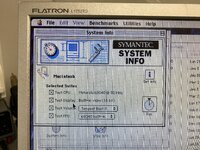
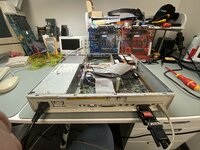
I also took a picture of the clock signal out of the Spicy. I'm surprised as it looked cleaner with no load, ie was a very nice sinusoid. Is that kind of waveform expected ?
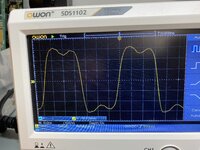
And also watch the quality of the PSU caps. They all "looked" fine with no leaks, but this does not mean they are still at their nominal values.
I know partially put the Mac back in the case so I could plug the HD more easily. Please do not blame me if it doesn't look right yet !
You can see a successful boot @ 30 MHz with ADB plugged in, so quite ok. It did freeze a few minutes after boot, but keep in mind it's currently a test bench, and when the case is opened there is no airflow.


I also took a picture of the clock signal out of the Spicy. I'm surprised as it looked cleaner with no load, ie was a very nice sinusoid. Is that kind of waveform expected ?

Unrelated comment: I ordered the owon scope pictured but the shop said it was no longer available. I like my owon desktop meter so wanted to match, oh well. Ended up ordering a Hantek with waveform gen.OK, so I need to try that, I had seen the video from @JDW about it.
And also watch the quality of the PSU caps. They all "looked" fine with no leaks, but this does not mean they are still at their nominal values.
I know partially put the Mac back in the case so I could plug the HD more easily. Please do not blame me if it doesn't look right yet !
You can see a successful boot @ 30 MHz with ADB plugged in, so quite ok. It did freeze a few minutes after boot, but keep in mind it's currently a test bench, and when the case is opened there is no airflow.
View attachment 7269
View attachment 7268
I also took a picture of the clock signal out of the Spicy. I'm surprised as it looked cleaner with no load, ie was a very nice sinusoid. Is that kind of waveform expected ?
View attachment 7270
Now I just need to learn MORE on how to appropriately use the damn thing lol
Yes, I got it as a sales for about 180€ ($180 USD). Basic, but pretty cheap, and perfect for all the 65x or 68k machines which are all below 100 MHz.Unrelated comment: I ordered the owon scope pictured but the shop said it was no longer available. I like my owon desktop meter so wanted to match, oh well. Ended up ordering a Hantek with waveform gen.
Now I just need to learn MORE on how to appropriately use the damn thing lol

